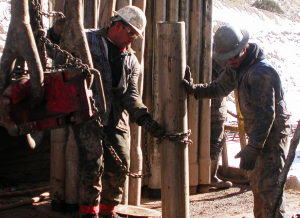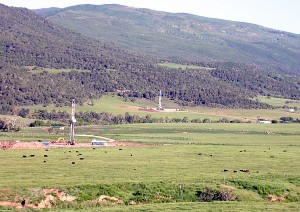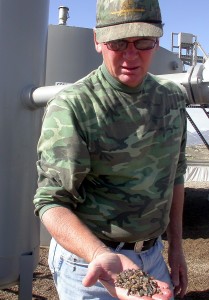 Susan Haire had taken just one step out of her pickup truck near her home above Battlement Mesa when an excruciating headache overcame her and she nearly passed out. She had been complaining of odd symptoms for months — chronic sinus problems, strange nerve sensations up and down her legs — but nothing like this.
Susan Haire had taken just one step out of her pickup truck near her home above Battlement Mesa when an excruciating headache overcame her and she nearly passed out. She had been complaining of odd symptoms for months — chronic sinus problems, strange nerve sensations up and down her legs — but nothing like this.
“It came on me like someone had hit both sides of my head with boards and I started to collapse,” said Haire, who was irrigating near a gas well when the incident occurred last June.
She has since complained of dizziness, disorientation and chemical sensitivity, and has taken to wearing breathing masks and respirators when she works outside to protect her from fumes she says she notices when others don’t.
Chris Mobaldi felt burning pains across her body for months, worsening until she could no longer dress herself. She became weak, chronically nauseous and developed a string of debilitating health problems culminating in a pair of pituitary gland tumors. In two years, friends said she aged 20 years. Most puzzling, a rare brain condition called foreign accent syndrome has left her speech sounding like she’s from another country, or sometimes reduced to total gibberish. She said she had smelled fumes from the surrounding gas wells for months and complained of tainted well water.
Karen Trulove began complaining of constant fatigue at her home south of Silt, and closed up her framing shop in town when she could no longer go to work. On the well pad above her home, a petroleum smell still fills the air, and on bad days she says the air around their home shares the same odor, accumulating in gullies and valleys on her land. Last week, she and her husband Tim put a “for sale” sign at the end of the road. Like Haire and Mobaldi, they are moving away from the industry they believe has made them sick.
Pollutants raise concerns

Tim Trulove stands by a condensate tank he believes is responsible for harmful air emissions near his home. David Frey photo.
Throughout the gas fields of western Garfield County, dozens of residents have complained of health problems they believe are caused by the wells that have spread across the rolling sagebrush landscape. Complaints include dizziness, nausea, difficulty breathing, sinus problems, eye and skin irritation and blistering. More severe concerns have included cancer, neurological disorders and acute chemical sensitivities.
“I’ve talked to people from Silt that are complaining about the exact same symptoms as outside of Parachute. Those folks have similar symptoms as people from outside of Rifle,” said Matt Sura, energy organizer with the activist group Western Colorado Congress. “These are so consistent that there has to be some sort of causation there. And the one thing they have in common is … that they live near oil and gas.”
Industry representatives say they’ve never seen proof of a connection. The Colorado Oil and Gas Conservation Commission, which regulates the industry, has investigated several such complaints and has never found any well responsible for health problems due to air quality.
But some recent Garfield County air samples have shown unusually high levels of volatile organic compounds from the gas industry, raising concerns among some state health officials that the industry’s expansion may be causing air pollution. That’s caused speculation for the first time that gas drilling could be harming neighbors’ health.
“I think that’s the question we want to answer ourselves,” said Ray Mohr, with the Air Pollution Control Division of the Colorado Department of Public Health and Environment. “I think at this point, based upon what we’ve seen, we’re led to conclude that might be the case, although we’re not definitely saying that at this point.”
Industry questions link
The county has begun monitoring air quality and it’s embarked on a two-year study to examine residents’ health complaints related to the industry. Mohr and other state health officials have examined the county’s air samples.
“There are hundreds of thousands of gas wells located clear across the United States, and across the world for that matter,” said Brian Macke, director of the Colorado Oil and Gas Conservation Commission, which regulates energy production. “I’m not familiar with occurrences of health impacts from oil and gas operations because of air impacts. That’s not to say that there aren’t any, but I just haven’t heard of those things, even from areas that have much higher (well) densities.”
Macke said his agency has received several complaints about air quality, but it’s never found evidence to link health problems to gas emissions. They have investigated complaints brought by Haire, Mobaldi, Trulove and others, but found no ties to nearby wells.
“While the Oil and Gas Commission is very concerned about any potential health impact from the gas industry, we do believe it’s very important to consider other environmental factors or personal health history factors when looking into health problems,” he said.
Industry representatives say they’ve never seen a link between their emissions and human health.
“Our experience has been that gas production activities in areas that are proximate to where people live have not been a problem and have not been shown to be a problem,” said Greg Schnacke, senior vice president of the trade group the Colorado Oil and Gas Association.
Air monitor results mixed
While some residents have complained that clear Western skies sometimes become smoggy, most Garfield County air monitors have found few traces of pollution traced to the gas industry, and those chemicals have been well within safe levels.
A few spot samples taken by residents participating in the program, though, have found highly-elevated levels of these volatile organic compounds, said Jim Rada, Garfield County’s environmental health manager. Those samples, taken when residents have noticed strong odors in the air, have shown spikes in BTEX — a mix of benzene, toluene, ethylbenzene and xylene. Although much higher than usual, those spikes were still well within occupation levels considered safe.
Some neighbors worry they may be at risk from chronic exposure.
“We had no idea that staying here with the finished wells would be so hard for us,” said Karen Trulove, who found high BTEX readings when she took an air sample. She and her husband are leaving their home of 12 years, a 40-acre spread with 11 horses that graze amid the sagebrush meadows where they had hoped to spend the rest of their lives.
The county has set up monitoring stations throughout the county that take monthly 24-hour samples. Environmentalists worry that while those stations may gauge general air quality, they miss plumes from specific wells that have accidents or heavy emissions. The county has given eight grab sample monitors for residents in areas of heavy activity to use when they smell fumes. Those monitors, like the one Trulove used, came up with the highest BTEX levels.
“I think that we’re all at a point where we know there’s a need to do more monitoring before we go out and say there’s a specific problem or not,” said Mohr, with the Air Pollution Control Division. It’s too early to link the gas industry to Garfield County health problems, he said, but after seeing high readings, officials can’t dismiss it.
‘Easy to point a finger’
The county has contracted with the Saccomanno Research Institute, of St. Mary’s Hospital in Grand Junction, to conduct a two-year study of residents’ health complaints relating to the gas industry to see if there may be a link.
“It’s somewhat easy to point a finger, but we have to realize, too, that in any given community there’s a certain number of these types of maladies that occur naturally,” said Rada, the county health manager. “Sometimes it’s related to environmental causes. Sometimes it’s related to genetics or personal health issues or lifestyle issues. It’s hard to put a finger on it, I’m sorry to say.”
Several residents, convinced that the gas industry is the source of their problems, have moved away, often leaving behind dream homes where they had hoped to retire, and some say their symptoms have improved ever since. Some have moved on after reaching cash settlements with energy companies, with provisions that they don’t speak publicly about their complaints.
“It was a feeling of being trapped,” said Susan Haire, who has moved into a friend’s home in East Texas and is trying to sell her home on Morrisania Mesa. “Being trapped inside the house while the environment was closing in on me. I did feel trapped and sacrificed and pretty angry.”
In an interview last fall, her nose was red and her eyes teary after working outside and she complained of forgetfulness and mental fogginess. During the winter, she said she was too chemically sensitive to use her home’s gas heat. Since she moved in early April, she said, most of her symptoms have disappeared, although she says she still has moments — reversing keys when she types or physical reactions to propane fumes.
Mobaldi said her strength has improved since leaving Rulison for Grand Junction, but her foreign accent syndrome has continued.
“These people know what they’re doing,” she said in halting speech with short vowels and rolled “r’s” reminiscent of an Eastern European accent. “They’ve done these things before. They just drill their gas wells without any thoughts of the peoples or the children or anything like that.”
Recent improvements

Flares, like this one at a pit holding drilling waste, are a rarity now as energy companies apply new technologies that better capture gases from drilling byproducts. David Frey photo.
Industry representatives acknowledge fumes as an inherent part of gas production. They may come from the gas byproducts, or condensate, that sometimes sits in pits or vented tanks at well sites. Sometimes, those pits are burned off, releasing more compounds in the air. Well flaring can also release them, and the wells themselves may emit some odors. Emissions may worsen when there is a mechanical problem.
The Truloves complain that a loose valve on a condensate tank on a well near their property has caused many of the emissions they’ve smelled, and frequent complaints to the company haven’t ended them.
“We aren’t anti-industry,” Tim Trulove said. “We just want them to manage themselves better.
Companies have made improvements in recent years. Many have stopped well flaring and burning condensate pits altogether.
“We take a lot of precautions to try to be sure we minimize emissions,” said Doug Hock, spokesman for EnCana Oil & Gas (USA), one of the biggest players in Garfield County’s gas fields. “It’s an ongoing thing. We always are looking at new technologies.”
At 34 well pads close to homes in Garfield County, the company uses combustors to burn off gases coming off tanks rather than release the fumes into the air. At an experimental facility north of Parachute, the company pumps away the condensate rather than storing it on site. The company also performs its own air monitoring for some emissions, but it doesn’t monitor for volatile organic compounds, like BTEX, which is says is difficult to accurately monitor.
“We are cognizant of the fact that (air quality) is a concern and it bothers landowners,” Hock said, “but as far as long-term health impacts, I’m not aware of it.”
‘It hit me so hard, so fast’
Most complaints center on the pits and tanks of condensate, which can contain some of the chemicals injected underground to fracture the underlying rock and make it easier for the gas to escape. Environmentalists complain that those chemicals are kept secret, so neighbors can’t know what they might be breathing.
“I think they’re truly experiencing some exposure and some exposure symptoms,” said Theo Colborn, an environmental health analyst in Paonia who has been an industry critic. “Unfortunately, everybody’s a little different. The mixes of these things are a little different. Basically what I’m fighting for is full disclosure.”
Concerns may also stem from more conventional sources. Dee Hoffmeister said the constant rumbling of diesel engines at a well site near her home south of Silt filled her home with fumes. She returned from a month-long family visit to find a gray cloud filling her front porch, she said, and the fumes caused her to pass out.
Hoffmeister said she spent weeks recuperating at a daughter’s home in Glenwood Springs while the energy company agreed to clean her home. She was weak, achy and had difficulty breathing, she said. She also complained of heightened chemical sensitivity. Even being near clothes at a department store caused a reaction, she said, and family members have complained of trouble breathing and reduced immunity.
“It hit me so hard, so fast,” she said. “I think it’s because we were gone. Those fumes just filled up our house.”
Industry representatives say neighbors’ fears are misplaced.
“The oil and gas industry certainly isn’t interested in having our processes impugned as being some sort of health hazard,” said COGA’s Schnacke. “We don’t believe they are.”
Schnacke points to the COGCC’s investigations into air quality complaints from neighbors that turned up nothing. “I’m not seeing evidence of health concerns in that population,” he said.
But Sura complains that the COGCC has no health specialists on staff.
‘Very hard to prove’
“It’s very hard to prove exactly what is to have caused an illness or an ailment,” said Jennifer Goldman, of the Durango-based environmental group the Oil & Gas Accountability Project, “but it shouldn’t be lost on anyone that these are environmental health issues.”
Cindee Nyland and her husband have rented the Mobaldis home for over a year. It’s a sweeping spread where deer, bald eagles and wild turkeys have come to visit. A well pad sits down the lane, and dozens more are scattered nearby. Lights from drilling rigs across the valley at the foot of the Roan Plateau shimmer at night.
“I haven’t seen any problems,” said Nyland, whose husband helps build roads for the gas industry. She said she hasn’t seen the polluted well water or smelled the gas fumes the Mobaldis complained of.
“I really think if the plants died or if I saw something really weird with the environment going on, it would bring questions to me,” she said, “but I haven’t seen any of that.”
For environmentalists like Goldman, though, the similar health complaints across the Rockies, from Alberta, Canada to the desert Southwest, where gas drilling has become prevalent, are too compelling to ignore.
“We don’t have solid studies to point to to say, ‘here’s what the chronic exposure is,’ but we do know that people are experiencing impacts when they’re living among those chemicals,” she said.
Among her neighbors south of Silt, Karen Trulove counts a half-dozen who have removed the batteries from their smoke alarms after they tired of hearing them mysteriously activated. She believes they were tripped by unseen chemicals in the air.
She and Tim are moving to an empty lot on Spring Valley to escape the gas industry and start over again, much as Haire, the Mobaldis and others like them have done.
“The whole thing is that these companies are above the law,” she said. “When they move into the neighborhood, your rights move out.”




